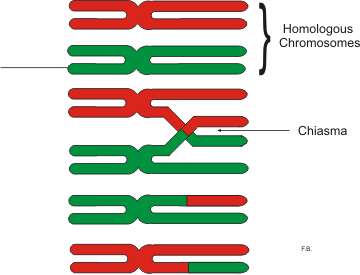Chiasma (genetics) on:
[Wikipedia]
[Google]
[Amazon]
 In
In
Recombination and the formation of chiasmata in meiosis
* Whitby, M. (2009), "Recombination and the formation of chiasmata in meiosis", in Millar, J. (ed.), The Cell Division Cycle: Controlling when and where cells divide and differentiate, The Biomedical & Life Sciences Collection, Henry Stewart Talks Ltd, London (online at http://hstalks.com/?t=BL0422198) Genetics Cell cycle
 In
In genetics
Genetics is the study of genes, genetic variation, and heredity in organisms.Hartl D, Jones E (2005) It is an important branch in biology because heredity is vital to organisms' evolution. Gregor Mendel, a Moravian Augustinian friar wor ...
, a chiasma (pl. chiasmata) is the point of contact, the physical link, between two (non-sister) chromatids belonging to homologous chromosome
A couple of homologous chromosomes, or homologs, are a set of one maternal and one paternal chromosome that pair up with each other inside a cell during fertilization. Homologs have the same genes in the same loci where they provide points alon ...
s. At a given chiasma, an exchange of genetic material can occur between both chromatids, what is called a chromosomal crossover, but this is much more frequent during meiosis
Meiosis (; , since it is a reductional division) is a special type of cell division of germ cells in sexually-reproducing organisms that produces the gametes, such as sperm or egg cells. It involves two rounds of division that ultimately r ...
than mitosis. In meiosis, absence of a chiasma generally results in improper chromosomal segregation and aneuploidy.
Points of crossing over become visible as chiasma after the synaptonemal complex dissembles and the homologous chromosomes slightly apart from each other.
The phenomenon of genetic chiasmata (''chiasmatypie'') was discovered and described in 1909 by Frans Alfons Janssens, a Professor at the University of Leuven in Belgium
Belgium, ; french: Belgique ; german: Belgien officially the Kingdom of Belgium, is a country in Northwestern Europe. The country is bordered by the Netherlands to the north, Germany to the east, Luxembourg to the southeast, France to th ...
.
When each tetrad
Tetrad ('group of 4') or tetrade may refer to:
* Tetrad (area), an area 2 km x 2 km square
* Tetrad (astronomy), four total lunar eclipses within two years
* Tetrad (chromosomal formation)
* Tetrad (general relativity), or frame field
** Tetra ...
, which is composed of two pairs of sister chromatids, begins to split, the only points of contact are at the chiasmata. The chiasmata become visible during the diplotene stage of prophase I of meiosis
Meiosis (; , since it is a reductional division) is a special type of cell division of germ cells in sexually-reproducing organisms that produces the gametes, such as sperm or egg cells. It involves two rounds of division that ultimately r ...
, but the actual "crossing-overs" of genetic material are thought to occur during the previous pachytene
Meiosis (; , since it is a reductional division) is a special type of cell division of germ cells in sexually-reproducing organisms that produces the gametes, such as sperm or egg cells. It involves two rounds of division that ultimately res ...
stage. Sister chromatids also form chiasmata between each other (also known as a chi structure), but because their genetic material is identical, it does not cause any noticeable change in the resulting daughter cells.
In humans, there seems to be one chiasma per chromosome arm, and in mammals, the number of chromosome arms is a good predictor of the number of crossovers. Yet, in humans and possibly other species, evidence shows that the number of crossovers is regulated at the level of an entire chromosome and not an arm.
The grasshopper ''Melanoplus femurrubrum
''Melanoplus femurrubrum'', the red-legged grasshopper, is a species of grasshopper belonging to the genus '' Melanoplus''. It is one of the most common grasshoppers found in Mexico, the United States, and Canada. This grasshopper is frequently u ...
'' was exposed to an acute dose of X-rays during each individual stage of meiosis, and chiasma frequency was measured. Irradiation during the leptotene-zygotene stages of meiosis, that is, prior to the pachytene period in which crossover recombination occurs, was found to increase subsequent chiasma frequency. Similarly, in the grasshopper ''Chorthippus brunneus'', exposure to X-irradiation during the zygotene-early pachytene stages caused a significant increase in mean cell chiasma frequency. Chiasma frequency was scored at the later diplotene-diakinesis stages of meiosis. These results suggest that X-rays induce DNA damages, likely including double-strand breaks, and these damages are repaired by a crossover pathway leading to chiasma formation.
See also
* Genetic recombination * Chromosomal crossover *Bivalent (genetics)
A bivalent is one pair of chromosomes (sister chromatids) in a tetrad. A tetrad is the association of a pair of homologous chromosomes (4 sister chromatids) physically held together by at least one DNA crossover. This physical attachment allows ...
* Holocentric chromosome Holocentric chromosomes are chromosomes that possess multiple kinetochores along their length rather than the single centromere typical of other chromosomes. They were first described in cytogenetic experiments in 1935. Since this first observation, ...
References
{{reflistExternal links
Recombination and the formation of chiasmata in meiosis
* Whitby, M. (2009), "Recombination and the formation of chiasmata in meiosis", in Millar, J. (ed.), The Cell Division Cycle: Controlling when and where cells divide and differentiate, The Biomedical & Life Sciences Collection, Henry Stewart Talks Ltd, London (online at http://hstalks.com/?t=BL0422198) Genetics Cell cycle